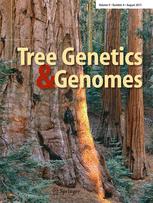Ver ítem
- xmlui.general.dspace_homeCentros Regionales y EEAsCentro Regional Patagonia NorteEEA BarilocheArtículos científicosxmlui.ArtifactBrowser.ItemViewer.trail
- Inicio
- Centros Regionales y EEAs
- Centro Regional Patagonia Norte
- EEA Bariloche
- Artículos científicos
- Ver ítem
Integrating genetics and suitability modelling to bolster climate change adaptation planning in Patagonian nothofagus forests
Resumen
We investigated the impact of past changes in habitat suitability on the current patterns of genetic diversity of two southern beeches (Nothofagus nervosa and Nothofagus obliqua) in their eastern fragmented range in Patagonian Argentina, and model likely future threats to their population
genetic structure. Our goal was to develop a spatially-explicit strategy for guiding conservation and management interventions in light of climate change. We combined
[ver mas...]
We investigated the impact of past changes in habitat suitability on the current patterns of genetic diversity of two southern beeches (Nothofagus nervosa and Nothofagus obliqua) in their eastern fragmented range in Patagonian Argentina, and model likely future threats to their population
genetic structure. Our goal was to develop a spatially-explicit strategy for guiding conservation and management interventions in light of climate change. We combined suitability modelling under current, past (Last Glacial Maximum ~ 21,000 BP), and future (2050s) climatic conditions with genetic
characterization data based on chloroplast DNA, isozymes, and microsatellites.We show the complementary usefulness of the distribution of chloroplast haplotypes and locally common allelic richness calculated from microsatellite data for identifying the locations of putative glacial refugia. Our findings suggest that contemporary hotspots of genetic diversity correspond to convergence zones of different expansion routes, most likely as a consequence of admixture processes. Future suitability predictions suggest that climate change
might differentially affect both species. All genetically most diverse populations of N. nervosa and several of N. obliqua are located in areas that may be most severely impacted by climate change, calling for forward-looking conservation interventions.
We propose a practical spatially- explicit strategy
to target conservation interventions distinguishing priority
populations for in situ conservation (hotspots of genetic
diversity likely to remain suitable under climate change),
ex situ conservation in areas where high genetic diversity
overlaps with high likelihood of drastic climate change,
vulnerable populations (areas expected to be negatively affected
by climate change), and potential expansion areas under
climate change.
[Cerrar]

Autor
Marchelli, Paula;
Thomas, Evert;
Azpilicueta, Maria Marta;
Zonneveld, Maarten van;
Gallo, Leonardo Ariel;
Fuente
Tree genetics & genomes 13 : 119. (December 2017)
Fecha
2017
ISSN
1614-2942 (Print)
1614-2950 (Online)
1614-2950 (Online)
Formato
pdf
Tipo de documento
artículo
Palabras Claves
Derechos de acceso
Restringido
 Excepto donde se diga explicitamente, este item se publica bajo la siguiente descripción: Creative Commons Attribution-NonCommercial-ShareAlike 2.5 Unported (CC BY-NC-SA 2.5)
Excepto donde se diga explicitamente, este item se publica bajo la siguiente descripción: Creative Commons Attribution-NonCommercial-ShareAlike 2.5 Unported (CC BY-NC-SA 2.5)

